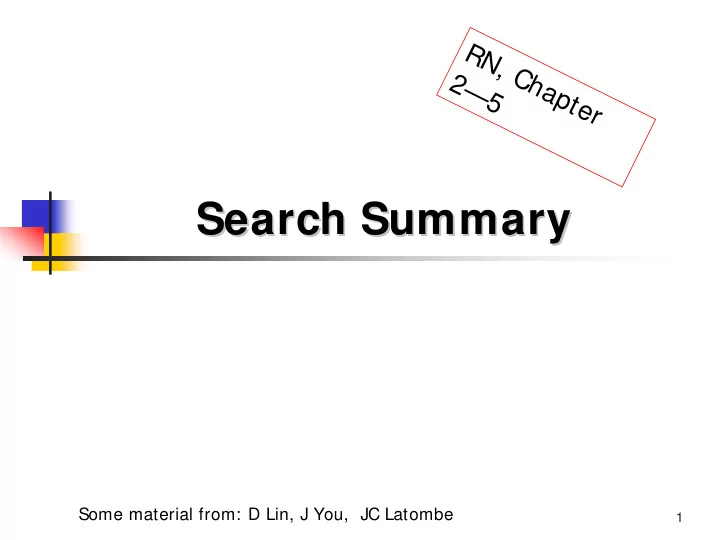

RN, Chapter 2—5 Search Summary Search Summary Some material from: D Lin, J You, JC Latombe 1
Search Summary # 1 � Problem Solving as Search � Blind Search Techniques � Breadth-first (uniform cost) � Depth-first � “Iterative Deepening” � Bi-Directional � Time/ Space Complexity: Size of search space: ≈ 10 11 nodes 2
Search Summary # 2 � Heuristic Search Techniques … using “Distance to Goal” � Best-First � A * : provably optimal! Search space ≈ 10 25 nodes (IDA * ) � Heuristic Functions 3
Search Summary # 3 � Constraint Satisfaction Problems � Intro CSP (Def’n, Types, Examples) � Complexity � Tricks for “Grow” approach � (arc) consistency + probagation � Backward checking (DFS) � Forward Checking � Variable / Value ordering � Constraint Optimization Problems 4
Search Summary # 4 � Iterative Algorithms � Framework, Examples � Hill-climbing / Gradient Descent � Problem / Issues � GSAT, WalkSat � Other approaches � Simulated Annealing, Tabu, Random Restarts, Genetic Algorithms ⇒ Search space ≈ 10 100 to 10 1000 5
Search Summary # 5 � Adversary Saerch / Game Playing � Minimax ≈ 10 10 nodes, 6-7 ply in chess � Alpha-beta Pruning ≈ 10 20 nodes, 14 ply in chess provably “optimal” 6
Other Topics � wrt Search � Iterative BROADENING � Memory Bounded Search – SMA * � Beam Search � Island Hopping – abstraction � … � wrt CSPs � Backjump � Dynamic Orderings � Special cases (eg, when arc-consistency is sufficient) 7
Search and AI Q: Why such a central role? A: As many AI tasks are ill-specified and/or intractable , Search is ONLY approach � Many applications of search: Learning, Reasoning, Planning, Design, GamesPlaying, NLU, Vision, … � Good news: Tremendous recent progress 10 30 feasible; often to 10 1000 � QUALITATIVE DIFFERENCE from only a few years ago!! 8
Recommend
More recommend